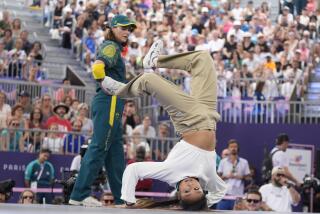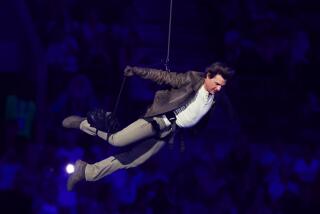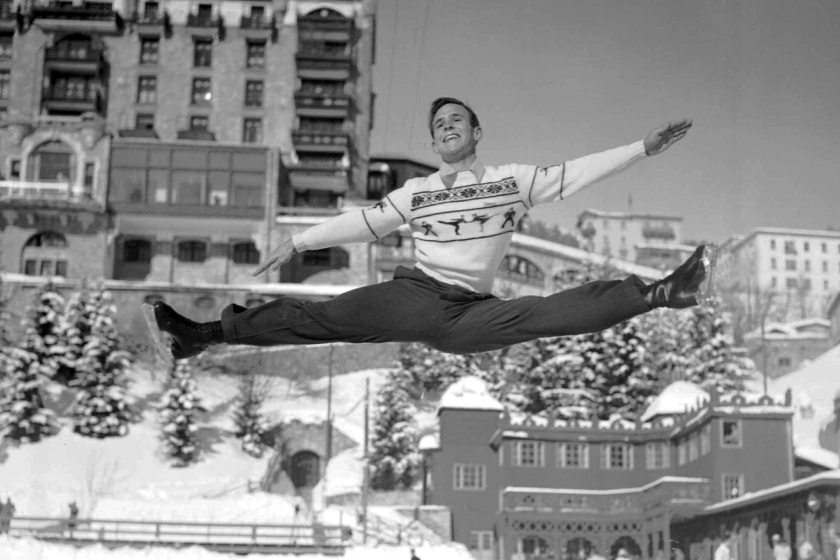Silver squeak
- Share via
LONDON — A day before the joy and celebration of Friday’s ceremonies open the London Games, mourners at the San Diego Yacht Club filed past two images of history en route to paying respects to a great Olympian.
Jack Davis had died. He was 81 and hale and hearty until just a month or so ago. Now, these Olympics will go on without the presence of one of the world’s true Gamers.
Another symbolic prop for this waterfront memorial service would have been the fishing boat Davis once owned, docked nearby. It was named “The Hurdler,” because that’s what he was.
Arguably, for much of the first six years of the 1950s, Jack Davis was the best hurdler in the world. Harrison Dillard and Lee Calhoun, also U.S. Olympians, might dispute that, especially because they got the gold medals and Davis was left with two silvers and two pictures of his two historic Olympic moments.
In 1952 in Helsinki, Davis and Dillard hit the tape at the end of the 110-meter hurdle final in 13.7 seconds. Dillard got the gold in a photo finish. In 1956 in Melbourne, Davis and Lee Calhoun hit the tape at the end of the 110-meter hurdles in 13.5 seconds. Calhoun got the gold in a photo finish.
It was these photos, with the respective silver medal draped over each, that put Thursday’s service in perfect perspective for the 200 attending mourners.
Most were close friends who knew the story, knew how Davis had won 37 races in a row in one span in the 1950s and had the world record at 13.4 for four years. Now, 60 years later, that record has been reduced by only 0.53 to 12.87. Attendees knew he had been the toast of USC track and field with NCAA hurdling titles in ‘51, ’52 and ‘53, years when the team was winning NCAA titles as well.
They knew he never wandered from his devotion to USC -- he once was given the school’s Order of the Diamond as the person contributing the most in dedication to the school that year. He had a similar dedication to the Olympics, once serving as an ambassador to the Olympics, at the request of the U.S. State Department, that took him all over the world, including 67 African cities. When San Diego got its U.S. Olympic Training Center, Davis was important in the effort.
Davis and first wife, Betty Strevey, raised their three children, Jackie, Trent and Tracy, as Jack became a successful developer in the Rancho Bernardo area and Park City, Utah.
But those silver-medal moments in Helsinki and Melbourne, as well as the waiting and pacing in the infields as the photos of the finishes were viewed, never drifted far from his mind, nor from representing a lifetime legacy.
“I don’t think many people know how hard he worked to make sure he got the gold the second time,” says his daughter, Jackie Gray. “In ‘52, dad crossed the finish line chest-first; Dillard foot first. So, my dad worked, for the next four years, to make sure he corrected that. When he hit the finish in Melbourne, he hit with his foot on the line, Calhoun with his chest.”
She says that Davis was eventually told by Olympic officials that the photos showed he had lost to Dillard by a yard and to Calhoun by an inch, despite the same finishing time in each race.
Davis was a world traveler. At one of his track and field ambassador stops in Ethiopia, he met a visiting President Nixon, who was a track fan and who said, “Jack, you still hold the world record at 13.4, right?”
Jackie says her dad never got over that.
“It was stunning to him that the president of the United States would know something about him,” she says.
He wanted one last trip this summer. He was healthy, but he knew, at 81, there would be few chances for more. So he headed to Italy with wife Carol in mid-June and took a bad fall on the island of Elba, breaking his leg. As they completed work on the fracture, inserting pins, early signs of organ failure began during his hospital stay in Italy. Eventually, the family was able to work out the complicated -- and expensive -- details to get him home.
On July 13, a plane equipped with proper medical facilities and a failing Jack Davis went from Rome to Luxembourg to Iceland to Goose Bay, Canada, to Edmonton and finally to San Diego. Davis died July 20 at Scripps Mercy Hospital in San Diego.
“Our decision to get him back,” Jackie says, “was all about whether he would die in Italy or at home.”
Had he still been around, Davis would have had his usual party for family and friends Friday to watch the opening ceremony. He would have reeled off statistics and regaled everybody with Olympic stories. One they had already heard but would probably hear again.
It was the story about his U.S. teammates in 1952, passing a USC sweat shirt from gold medalist to gold medalist. Shotputter Parry O’Brien wore it and won gold. He passed it to discus thrower Sim Iness, who won gold. Iness passed it to javelin thrower Cy Young, who won gold. When it was offered to Davis, he balked because the shirt was pretty gamy by then. And, of course, Davis didn’t win gold.
“He still talked about that a lot,” Jackie says. “I think he regretted, to his dying moment, not wearing that shirt.”
Similarly, the Olympic world, on the eve of opening another chapter of spirit and happiness, should regret having to do so without Jack Davis leading the cheers.
--
More to Read
Go beyond the scoreboard
Get the latest on L.A.'s teams in the daily Sports Report newsletter.
You may occasionally receive promotional content from the Los Angeles Times.







